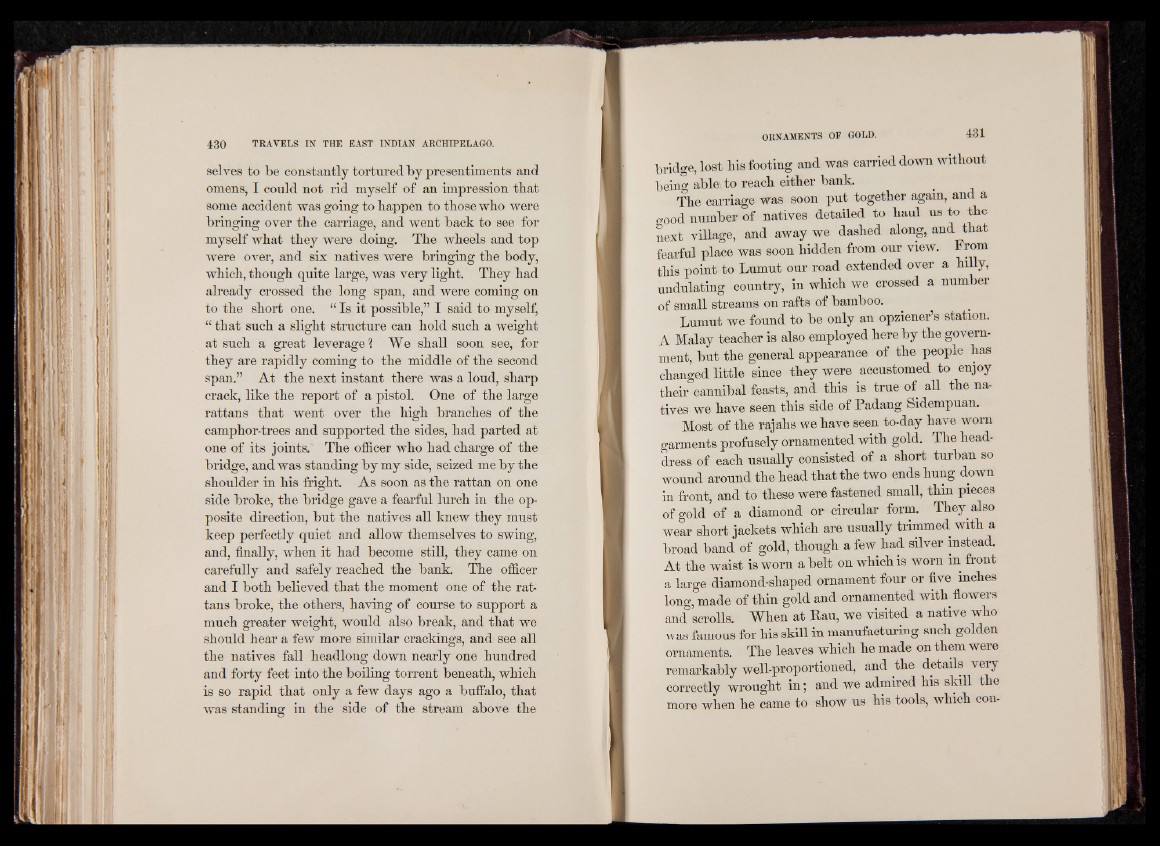
selves to be constantly tortured by presentiments and
omens, I could not rid myself of an impression tbat
some accident was going to happen to those who were
bringing over the carriage, and went back to see for
myself what they were doing. The wheels and top
were over, and six natives were bringing the body,
which, though quite large, was very light. They had
already crossed the long span, and were coming on
to the short one. “ Is it possible,” I said to myself,
“ that such a slight structure can hold such a weight
at such a great leverage % We shall soon see, for
they are rapidly coming to the middle of the second
span.” At the next instant there was a loud, sharp
crack, like the report of a pistol. One of the large
rattans that went over the high branches of the
camphor-trees and supported the sides, had parted at
one of its joints.' The officer who had charge of the
bridge, and was standing by my side, seized me by the
shoulder in his fright. As soon as the rattan on one
side broke, the bridge gave a fearful lurch in the opposite
direction, but the natives all knew they must
keep perfectly quiet and allow themselves to swing,
and, finally, when it had become still, they came on
carefully and safely reached the bank. The officer
and I both believed that the moment one of the rattans
broke, the others, having of course to support a
much greater weight, would also break, and that we
should hear a few more similar crackings, and see all
the natives fall headlong down nearly one hundred
and forty feet into the boiling torrent beneath, which
is so rapid that only a few days ago a buffalo, that
was standing in the side of the stream above the
bridge, lost his footing and was carried down without
being able\ to reach either bank.
The carriage was soon put together again, and a
good number of natives detailed to haul us to the
next village, and away we dashed along, and that
fearful place was soon hidden from our view. From
this point to Lumut our road extended over a hilly,
undulating country, in which we crossed a number
of small streams on rafts of bamboo.
Lumut we found to be only an opziener’s station.
A Malay teacher is also employed hereby the government,
but the general appearance of the people has
changed little since they were accustomed to enjoy
their cannibal feasts, and this is true of all the natives
we have seen this side of Padang Sidempuan.
Most of the rajahs we have seen to-day have worn
garments profusely ornamented with gold. The headdress
of each usually consisted of a short turban so
wound around the head that the two ends hung down
in front, and to these were fastened small, thin pieces
of gold of a diamond or circular form. They also
wear short jackets which are usually trimmed with a
broad band of gold, though a few had silver instead.
At the waist is worn a belt on which is worn in front
a large diamond-shaped ornament four or five inches
long, made of thin gold and ornamented with flowers
and scrolls. When at Kau, we visited a native who
was famous for his skill in manufacturing such golden
ornaments. The leaves which he made on them were
remarkably well-proportioned, and the details very
correctly wrought in ; and we admired his skill the
more when he came to show us his tools, which con